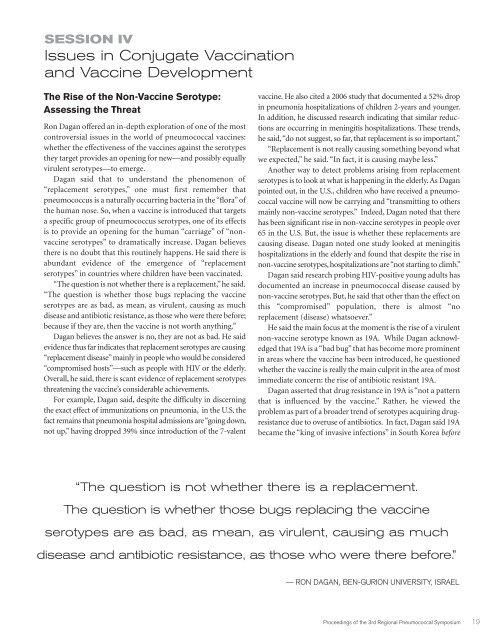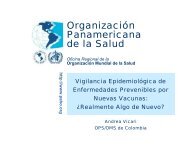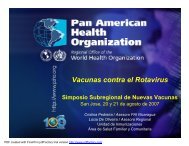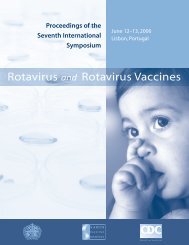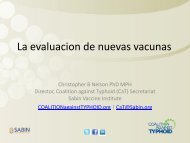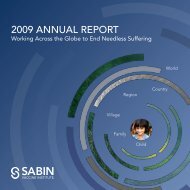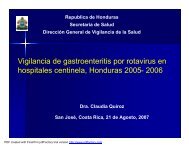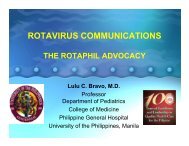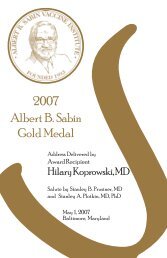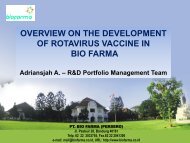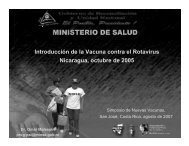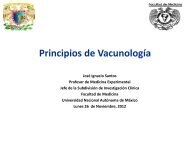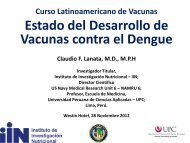3rd Pneumococcal Symposium web - Sabin Vaccine Institute
3rd Pneumococcal Symposium web - Sabin Vaccine Institute
3rd Pneumococcal Symposium web - Sabin Vaccine Institute
Create successful ePaper yourself
Turn your PDF publications into a flip-book with our unique Google optimized e-Paper software.
SESSION IV<br />
Issues in Conjugate Vaccination<br />
and <strong>Vaccine</strong> Development<br />
The Rise of the Non-<strong>Vaccine</strong> Serotype:<br />
Assessing the Threat<br />
Ron Dagan offered an in-depth exploration of one of the most<br />
controversial issues in the world of pneumococcal vaccines:<br />
whether the effectiveness of the vaccines against the serotypes<br />
they target provides an opening for new—and possibly equally<br />
virulent serotypes—to emerge.<br />
Dagan said that to understand the phenomenon of<br />
“replacement serotypes,” one must first remember that<br />
pneumococcus is a naturally occurring bacteria in the “flora” of<br />
the human nose. So, when a vaccine is introduced that targets<br />
a specific group of pneumococcus serotypes, one of its effects<br />
is to provide an opening for the human “carriage” of “nonvaccine<br />
serotypes” to dramatically increase. Dagan believes<br />
there is no doubt that this routinely happens. He said there is<br />
abundant evidence of the emergence of “replacement<br />
serotypes” in countries where children have been vaccinated.<br />
“The question is not whether there is a replacement,” he said.<br />
“The question is whether those bugs replacing the vaccine<br />
serotypes are as bad, as mean, as virulent, causing as much<br />
disease and antibiotic resistance, as those who were there before;<br />
because if they are, then the vaccine is not worth anything.”<br />
Dagan believes the answer is no, they are not as bad. He said<br />
evidence thus far indicates that replacement serotypes are causing<br />
“replacement disease” mainly in people who would be considered<br />
“compromised hosts”—such as people with HIV or the elderly.<br />
Overall, he said, there is scant evidence of replacement serotypes<br />
threatening the vaccine’s considerable achievements.<br />
For example, Dagan said, despite the difficulty in discerning<br />
the exact effect of immunizations on pneumonia, in the U.S. the<br />
fact remains that pneumonia hospital admissions are “going down,<br />
not up,” having dropped 39% since introduction of the 7-valent<br />
vaccine. He also cited a 2006 study that documented a 52% drop<br />
in pneumonia hospitalizations of children 2-years and younger.<br />
In addition, he discussed research indicating that similar reductions<br />
are occurring in meningitis hospitalizations. These trends,<br />
he said, “do not suggest, so far, that replacement is so important.”<br />
“Replacement is not really causing something beyond what<br />
we expected,” he said. “In fact, it is causing maybe less.”<br />
Another way to detect problems arising from replacement<br />
serotypes is to look at what is happening in the elderly. As Dagan<br />
pointed out, in the U.S., children who have received a pneumococcal<br />
vaccine will now be carrying and “transmitting to others<br />
mainly non-vaccine serotypes.” Indeed, Dagan noted that there<br />
has been significant rise in non-vaccine serotypes in people over<br />
65 in the U.S. But, the issue is whether these replacements are<br />
causing disease. Dagan noted one study looked at meningitis<br />
hospitalizations in the elderly and found that despite the rise in<br />
non-vaccine serotypes, hospitalizations are “not starting to climb.”<br />
Dagan said research probing HIV-positive young adults has<br />
documented an increase in pneumococcal disease caused by<br />
non-vaccine serotypes. But, he said that other than the effect on<br />
this “compromised” population, there is almost “no<br />
replacement (disease) whatsoever.”<br />
He said the main focus at the moment is the rise of a virulent<br />
non-vaccine serotype known as 19A. While Dagan acknowledged<br />
that 19A is a “bad bug” that has become more prominent<br />
in areas where the vaccine has been introduced, he questioned<br />
whether the vaccine is really the main culprit in the area of most<br />
immediate concern: the rise of antibiotic resistant 19A.<br />
Dagan asserted that drug resistance in 19A is “not a pattern<br />
that is influenced by the vaccine.” Rather, he viewed the<br />
problem as part of a broader trend of serotypes acquiring drugresistance<br />
due to overuse of antibiotics. In fact, Dagan said 19A<br />
became the “king of invasive infections” in South Korea before<br />
“The question is not whether there is a replacement.<br />
The question is whether those bugs replacing the vaccine<br />
serotypes are as bad, as mean, as virulent, causing as much<br />
disease and antibiotic resistance, as those who were there before.”<br />
— RON DAGAN, BEN-GURION UNIVERSITY, ISRAEL<br />
Proceedings of the <strong>3rd</strong> Regional <strong>Pneumococcal</strong> <strong>Symposium</strong> 19


